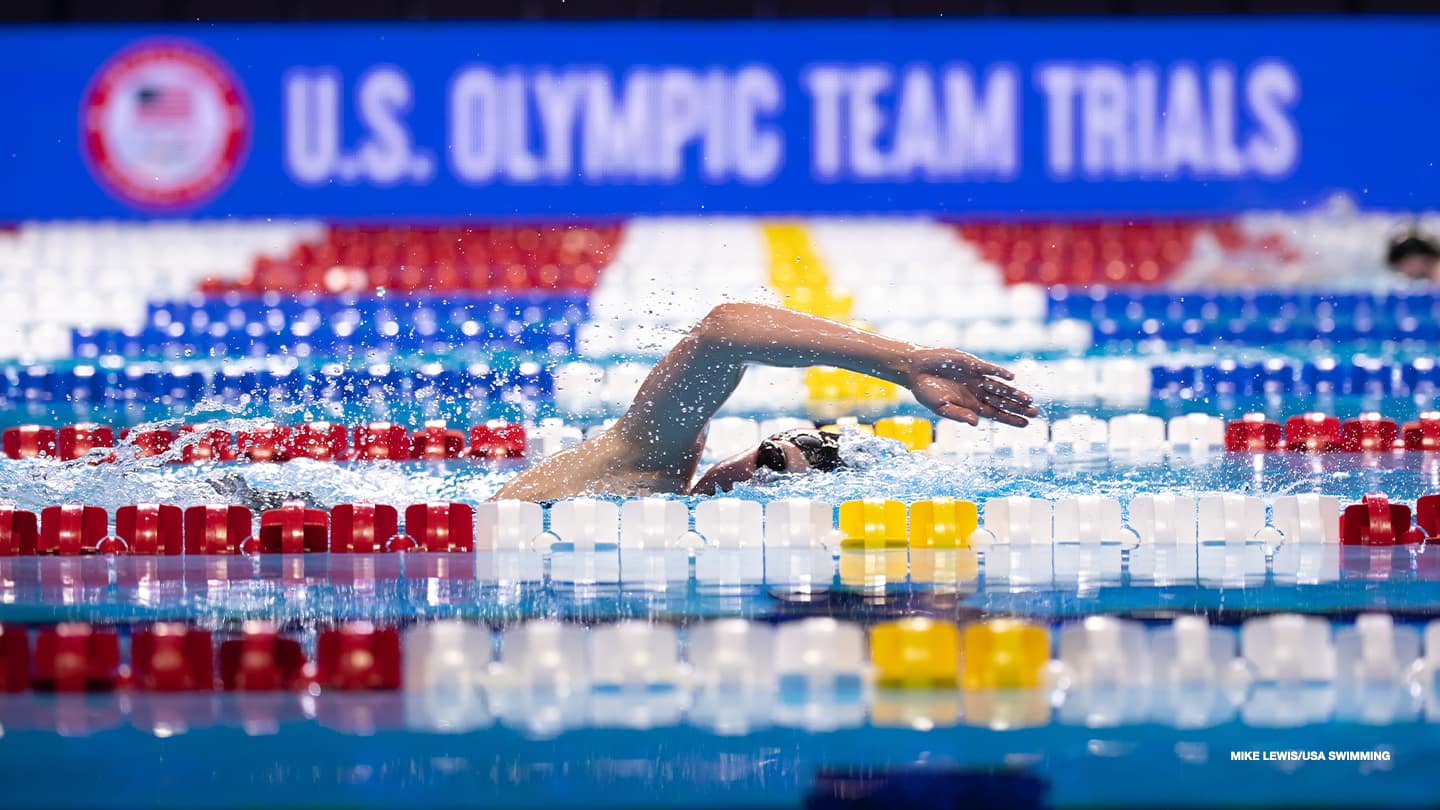
50 Athletes From Swimming’s U.S. Olympic Team Trials Wave I Qualify For Wave II
by Peggy Shinn

Aurora Roghair competes at U.S. Olympic Team Trials - Swimming Wave I on June 7, 2021 in Omaha, Neb.
Wave I of U.S. Olympic Team Trials—Swimming concluded on Monday evening, with 50 swimmers qualifying to compete in Wave II. The 50 swimmers qualified for Wave II by finishing first or second in at least one of the 28 finals held June 4-7 at the CHI Health Center Omaha. Of the 50, six qualified for Wave II in two events.
Wave II begins on Sunday, June 13, and over the following week, up to 52 American swimmers will qualify to compete at the Olympic Games Tokyo 2020.
Why Two Waves?
On March 24, 2020, USA Swimming made the decision to postpone the U.S. Olympic Team Trials—Swimming due to the Covid-19 pandemic and the International Olympic Committee’s decision to postpone the Tokyo Games. When trials were rescheduled for June 2021, USA Swimming announced a new format that would feature a Wave I and Wave II format. With ongoing pandemic and need to still limit large gatherings, the two waves—essentially two separate swim meets—would reduce the number of athletes, coaches, support staff, and spectators congregating at trials.
To differentiate between Wave I and Wave II swimmers, USA Swimming evaluated results from the past five U.S. Olympic Team Trials (2000 to 2016) and adjusted time standards. The Wave II time standard for each event was adjusted to the 41st seeded time. Swimmers who met that standard would qualify for Wave II.
Swimmers who qualified for trials under the original time standards but were not fast enough to qualify for Wave II were invited to compete in Wave I. The top two finishers in every race would qualify to compete in Wave II. These swimmers can swim all events in Wave II for which they have achieved the original qualifying standard.
Wave II serves as the sole U.S. Olympic Team Trials for pool swimmers.
Who Competed in Wave I?
At the end of the qualifying period (May 30, 2021), 892 swimmers had qualified for Wave I in at least one event; 651 qualified for Wave II.
Of the Wave I qualifiers, 748 swimmers made their first appearance at U.S. Olympic Team Trials—Swimming last weekend. About 42 percent were teenagers: 258 swimmers were 18 years old or younger; 148 were 23 and older. The youngest competitor was a newly minted 13 year old.
Navy Swimming had 21 athletes competing in Wave I—the most of all swim clubs. Nation’s Capital Swim Club had the largest non-collegiate contingent with 13 swimmers, one who qualified for Wave II in two events (Camille Spink). In all, 333 clubs from across the U.S. brought swimmers to Wave I trials.
By comparison, 196 clubs have swimmers who qualified for Wave II trials. Of the 600+ swimmers expected to compete in Wave II, 129 are aged 18 and under, and 198 are 23 and over (not including the 50 who qualified from Wave I).
Who Qualified For Two Wave II Events?
Of the 50 swimmers who qualified for Wave II by finishing first or second in at least one Wave I race, six qualified in two events:
University of Nebraska senior Autumn Haebig: 100 backstroke, 200 freestyle
Kate McCarville, who has committed to the University of Tennessee: 200 and 400 IMs
CAL swimmer Colby Medford: 200 butterfly, 200 backstroke
Malia Rausch, who has committed to Ohio State: 200 and 400 freestyles
Patrick Sammon, age 17, from California: 100 and 200 freestyles
Camille Spink, age 16, from Virginia: 50 and 100 freestyles
These swimmers, plus the other 44 Wave I qualifiers, will compete against 30 Olympians and 23 Olympic medalists next week in Wave II for a chance to make their first U.S. Olympic Team.
But competition will be tough. Of the Wave II competitors, 73 currently hold a top-ten time in the world in 2021 in an Olympic event. Most of the Wave I winners’ and runner-ups’ times barely met the Wave II time standard.
Spink’s coach, Jeremy Linn, summed up the Wave I experience for many of the young swimmers when he said: “We’re really excited for what Camille is capable of. And the most exciting part is being able to see her be able to thrive in this environment. That’s so important. This environment can scare a lot of young kids, it can scare a lot of older kids and instead of letting that be a part of what’s happening to her, it actually energizes her. It’s a lot of fun to see her in that light and be good under the lights.”